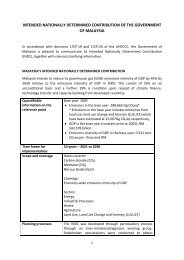RP-01638
RP-01638
RP-01638
Create successful ePaper yourself
Turn your PDF publications into a flip-book with our unique Google optimized e-Paper software.
made from a 0.5-inch (1.27-cm) thick plate.<br />
After drilling the central hole (slightly larger<br />
than the piston rod), the plate is cut into<br />
two similar halves. A third half-plate is<br />
required for mounting the assembly so that<br />
the movable half-piece is clear of the top-plate<br />
of the handpump. The Veeder-Root counter<br />
is mounted on the movable half-plate, which<br />
is spring-loaded to ensure constant contact of<br />
the rouer with the piston rod. The fixed halfplate<br />
should be mounted clear of the piston<br />
rod (taking into consideration any swing or<br />
inclination of the piston rod during the applied<br />
stroke).<br />
Work input The method used in the<br />
laboratory to determine work input is not<br />
suitable for use in the field because of the<br />
difficulty of transporting several pieces of<br />
sensitive electronic equipment and ensuring<br />
that they remain in good operating condition<br />
at the field site. Moreover, the method also<br />
requires a highly trained technician to carry<br />
out the measurements. It is, therefore, desirable<br />
to have a simpler, lighter, and more<br />
robust instrument that can be readily carried<br />
to the field and operated by a technician with<br />
minimal training.<br />
The mechanical instrument used to<br />
measure work input at the field site consists<br />
of essentially: (1) two steel bars, held together<br />
at both ends by adjustable clamps, that deflect<br />
relative to each other when a load is applied to<br />
the midpoints of the bars; (2) a dial gauge that<br />
magnifies the deflection of the steel bars;<br />
(3) an indicator drum that rotates the tracing<br />
paper as the instrument is displaced from a<br />
fixed position; and (4) a pen connected to the<br />
dial gauge by a string that is held taut by a<br />
recoiling spring. During the operation of the<br />
pump, the relative deflection of the bars, after<br />
being magnified by the dial gauge, causes the<br />
pen to move perpendicular to the rotation of<br />
the drum. The resultant diagram traced on<br />
the paper on the drum gives a forcedisplacement<br />
loop that is equivalent to that<br />
obtained by the laboratory method.<br />
The operating range of the mechanical<br />
instrument with respect to the applied force<br />
may be changed by changing the distance<br />
between the adjustable clamps so that the<br />
effective deflecting length of the steel bars is<br />
either reduced or increased.<br />
Field monitoring procedures<br />
Four separate sets of forms were used for<br />
monitoring pumps in the field. They were:<br />
(1) Form Ki was designed for use by Ministry<br />
of Health personnel to record counter readings<br />
at 2-week intervals; a second copy of this<br />
form, which was updated regularly, was kept<br />
at the University; (2) Form A (Well and Pump<br />
Specifications) was used to record basic information<br />
on the well and pump, and was completed<br />
before the start of the monitoring period; (3)<br />
Form B (Site Visit Data Sheet) was the basic form<br />
used for field monitoring and was divided into<br />
four sections - (a) mechanical performance<br />
(completed at each monthly visit), (b) maintenance<br />
operations (recorded when necessary),<br />
(c) wear measurements (measured bimonthly),<br />
and (d) user feedback (whenever possible<br />
during monthly visits); and (4) Form C (Failures<br />
and Repairs) was completed when a pump failed<br />
and included details of repairs and other<br />
measures taken.<br />
Although all 17 handpumps were installed<br />
and used by villagers for approximately 2 years,<br />
it was only during the last 8.5-month period<br />
that they were fully monitored.<br />
Field performance<br />
To facilitate comparison among handpumps,<br />
the data for all 17 were summarized (Table 1).<br />
Maintenance and repairs carried out on the<br />
pumps were also summarized (Table 2).<br />
Performance results were computed from<br />
field data for all 17 handpumps. Figure 8 gives<br />
an example of the results of the data for one<br />
pump. To isolate the effect of water head on<br />
the volumetric efficiency, plots of (1 - rjoi)1<br />
hT against calendar time were made for each<br />
handpump (see, for example, Fig. 9). There was<br />
considerable experimental scatter for small<br />
values of (1 - r)ol)IhT, which is equivalent to<br />
high values of qoi and low values of hT. For<br />
larger values of (1 - r)oi)Ih T the experimental<br />
points showed a more consistent trend. The<br />
straight lines through the experimental points<br />
were plotted using the method of least<br />
squares. For most cases, the expression<br />
(1 - qoi)IhTdecreased with calendar time indicating<br />
that the sealing efficiency improves<br />
with time.<br />
Variations of water head with calendar<br />
time showed a similar pattern of variation in<br />
each district, indicating the dry and wet<br />
seasons in the respective areas.<br />
The average volume of water delivered per<br />
day was computed from the counter readings<br />
(which were the sum of the piston travel)<br />
47



